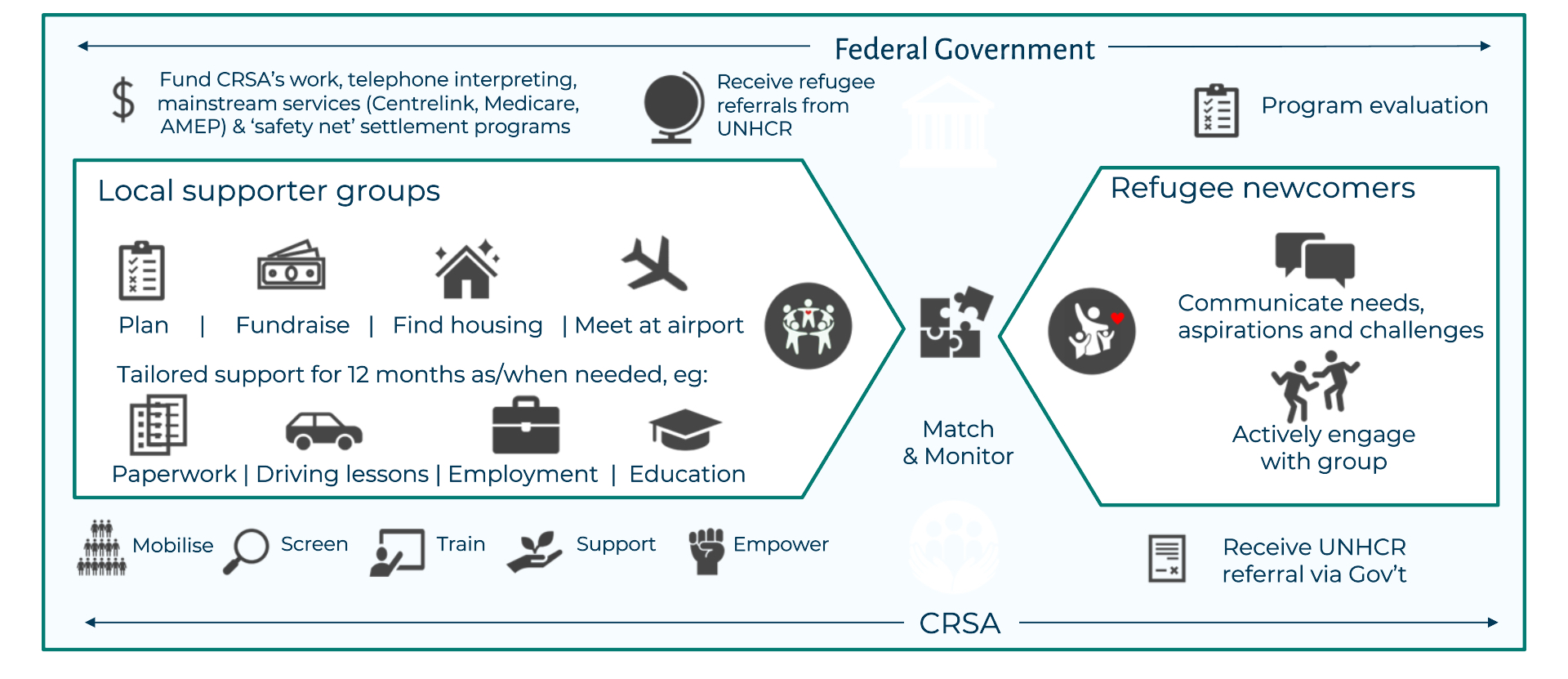Thank you!
CRISP factsheet
Last updated August 2023 | Feature photo: Mark Isaacs
What is the CRISP?
- The Community Refugee Integration and Settlement Pilot – known as the CRISP – is Australia’s new refugee sponsorship program.
- The first refugees arrived in August 2022 following the launch of the program in mid 2022.
- CRSA is funded by the Commonwealth Government to deliver the CRISP around Australia.
- The CRISP is inspired by the successful Canadian community refugee sponsorship program operating since the late 1970s, which has enabled more than 325,000 refugees to build a new life in Canada. Similar programs are now being implemented in around a dozen countries around the world, including the UK, US, NZ and Ireland.
- At the end of 2022, there were 108.4 million people forcibly displaced worldwide, including 35.3 million refugees. In 2024, the number of refugees identified by the UN Refugee Agency as being in urgent need of resettlement had grown to 2.4 million – a 21% increase on the previous year’s projection. In 2022, fewer than 4% of refugees in need were able to access resettlement but community sponsorship programs are helping to increase this number.
- In August 2023 the Australian government announced that it had expanded its humanitarian intake quota to 20,000 places per annum. The CRISP program is currently within this quota. The government aspires to having 10,000 additional resettlement places per annum for refugees and humanitarian migrants in the future, utilising community sponsorship and other ‘complementary pathways’ (such as labour and educational migration pathways for refugees). CRSA continues to advocate for the CRISP to become structurally ‘additional’ but is pleased that the CRISP is now making a contribution to an enlarged overall refugee intake.’
- See our February 2024 CRISP Data and Outcomeshere.
- See our July 2024 CRISP Data and Outcomes here.
Who benefits from the program?
- The Australian government selects refugees to participate in the program, drawing on those identified by the UNHCR as being in most urgent need of resettlement.
- Refugees arrive as permanent residents eligible for government-funded English classes, Centrelink support, Medicare and most other federal, state and local services.
How do volunteers get involved?
- To participate, Australians need to:
- form a local ‘Community Supporter Group’ or CSG of five or more adults;
- provide clear police and working with children checks;
- undergo some initial training; and
- commit to 12 months of practical hands-on support, including some fundraising.
- CSGs can be based in a community anywhere in Australia.
- CSGs operate as independent, self-governing and self-directing groups. While CRSA will provide them with training and support, CSG members are not representatives of CRSA.
What does the CSG do?
CSGs offer 12 months of practical hands-on support to the new arrivals. This includes:
- Fundraising for income support for the first 1-2 weeks
- Providing temporary accommodation for 4-6 weeks
- Meeting the new arrivals at the airport
- Helping the new arrivals to:
- Apply for a bank account
- Register for Centrelink support and other government services
- Enroll children in school
- Access language classes
- Local orientation including using public transport
- Providing access to social opportunities and emotional support
- Helping the new arrivals to secure long-term housing
Additional settlement and integration support is driven by the new arrivals’ needs and aspirations and could include help with getting a driver’s license, finding a job or starting a business, with an overall aim of self-sufficiency.
How many refugees will be supported?
The program aims to welcome and support 1,500 refugee newcomers over the course of the four year pilot (2022-2025).
How does the CRISP fit in with other ways for refugees to enter the country?
Refugees can enter Australia in other ways, including under the HSP (Humanitarian Settlement Program) and CSP (community support program). For more information, see the HSP, CSP and CRISP comparison published by the Department of Home Affairs.
Where is the program active?

